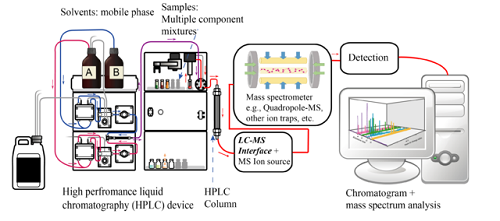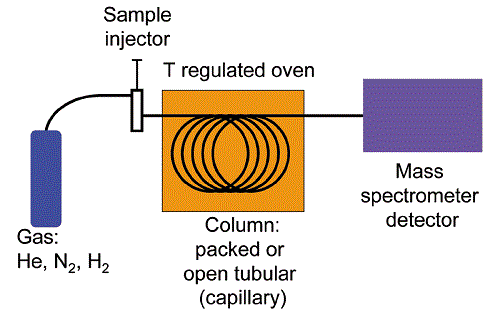Difference Between GC-MS and LC-MS

LC-MS
GC-MS vs. LC-MS
Sorting the different elements of a mixture can be easy or difficult depending on the type of mixture or sample involved. In order to identify and account for all substances in a particular difficult sample or mix, LC-MS or GC-MS can be used to ease and hasten the identification process.
“LC-MS” is the abbreviated form of “liquid chromatography mass spectrometry.” The machine is the combination of two previously singular machines – the liquid chromatography and the mass spectrometry. The liquid chromatography separates the physical makeup of the mixture, while the mass spectrometry deals with mass analysis.
The LC-MS is also a technique in the field of analytical chemistry used in a process that requires the identification of substances and elements. The technique is often applied to processes that require a high sensitivity and selectivity of the materials being identified. It is often used to make a specific detection of materials in a combined state. LC-MS can be used for non-volatile and thermally fragile molecules. The technique can be utilized to separate a wide variety of organic compounds from metabolites to proteins.
LC-MS can give both two- and three-dimensional data because of its detectors. Refractive index, as well as electrochemical, fluorescence, and ultraviolet-visible (UV-Vis) detectors are among the traditional detectors of LC-MS. The mass spectrometry part presents three-dimensional data that includes the molecular weight, structure, density, quantity, and purity of a sample.
Most applications of LC-MS are in the following fields and markets:
The pharmacokinetics market (in layman’s terms, studies that involve pharmaceuticals), which includes drug discovery, metabolism (involving the structural identification and quantitation of metabolites), quantitation of toxicology, as well as the sensitivity, precision, and accuracy in pre-clinical and clinical studies of pharmacokinetics and contact research organizations. Also included are the formulation, quality control, and production in generic drug companies.
Biotechnology market – usually involved in protein characterization, proteomics, quality control, nucleotides, and carbohydrates.
Agrochemical market–used in compound discovery, metabolism, toxicology, pharmacokinetics, and quality control and production.
Industrial markets – a tool for determining the structure of organometallics, quality control, and competitor products of detergents and molecular weight in addition to the structure of polymers.
Environmental market–ID and quantitation of pollutants in water, contaminants and toxins in food, contaminates and illegal substances in animal feeds.
Forensic market – often used in testing for illegal substances and toxic agents at crime scenes, illegal substances in body makeup (in drug testing), and explosives.
Academia–used in fundamental research and teaching.
Among the LC-MS advantages are: higher sample throughput, shorter method development, nether sensitivity, and unequivocal ID.

GC-MS
On the other hand, GC-MS is the short form for gas chromatography mass spectrometry. Its main difference from the other identification and separation technique is that it is used for samples that are thermally stable molecules.
GC-MS usually has same application as LC-MS – to identify any foreign material and contamination in a sample. However, GC-MS has the leverage of being the preferred standard for forensic science identification, since it tests for specific substances and not for a general composition or identification. GC-MS is also the preferred machine to use because it is easier to operate, has fewer maintenance issues, and costs less compared to the LC-MS machine.
Summary:
1.Both LC-MS and GC-MS are methods to separate chemicals in a mixture or a sample. Both methods separate the chemicals by chromatography first, then further examine and identify them by the mass spectrometer.
2.Both methods require a mobile phase and a stationary phase. The only difference is that LC-MS uses a solvent as its mobile phase, while GC-MS uses inert gases (like helium) in the same capacity.
3.GC-MS is the preferred standard for forensic identification, and it is also the preferred machine in terms of costs and operation.
- Differences Between Fraternity And Sorority - January 8, 2014
- Differences Between Lucite and Plastic - January 7, 2014
- Differences Between Oil and Butter - January 6, 2014
Search DifferenceBetween.net :
 Email This Post
: If you like this article or our site. Please spread the word. Share it with your friends/family.
Email This Post
: If you like this article or our site. Please spread the word. Share it with your friends/family.
1 Comment
Leave a Response
References :
[0]https://commons.wikimedia.org/wiki/File:Gcms_schematic.gif
[1]https://en.wikipedia.org/wiki/File:Liquid_chromatography_tandem_Mass_spectrometry_diagram.png


Why lc ms is better than gcms Ms?